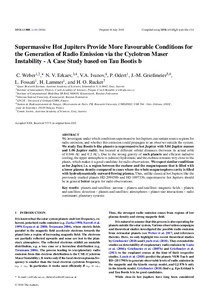Supermassive hot Jupiters provide more favourable conditions for the generation of radio emission via the cyclotron maser instability - a case study based on Tau Bootis b
Автор:
Weber, C.
Erkaev, N. V.
Ivanov, V. A.
Odert, P.
Grießmeier J.-M.
Fossati, L.
Lammer, H.
Rucker, H. O.
Коллективный автор:
Политехнический институт
Кафедра прикладной механики
Дата:
2018Журнал:
Monthly Notices of the Royal Astronomical SocietyКвартиль журнала в Scopus:
Q1Квартиль журнала в Web of Science:
Q1Библиографическое описание:
Weber, C. Supermassive hot Jupiters provide more favourable conditions for the generation of radio emission via the cyclotron maser instability - a case study based on Tau Bootis b [Текст] / C. Weber, N. V. Erkaev, V. A. Ivanov, P. Odert, Grießmeier J.-M., L. Fossati, H. Lammer, H. O. Rucker // Monthly Notices of the Royal Astronomical Society. — 2018. — Т. 480 (№ 3). — С. 3680-3688Аннотация:
We investigate under which conditions supermassive hot Jupiters can sustain source regions for radio emission, and whether this emission could propagate to an observer outside the system. We study Tau Bootis b-like planets (a supermassive hot Jupiter with 5.84 Jupiter masses and 1.06 Jupiter radii), but located at different orbital distances (between its actual orbit of 0.046 and 0.2 au). Due to the strong gravity of such planets and efficient radiative cooling, the upper atmosphere is (almost) hydrostatic and the exobase remains very close to the planet, which makes it a good candidate for radio observations. We expect similar conditions as for Jupiter, i.e. a region between the exobase and the magnetopause that is filled with a depleted plasma density compared with cases where the whole magnetosphere cavity is filled with hydrodynamically outward flowing ionospheric plasma. Thus, unlike classical hot Jupiters like the previously studied planets HD 209458b and HD 189733b, supermassive hot Jupiters should be in general better targets for radio observations.
Коллекции:
Метаданные:
Показать полную информациюСвязанные материалы
Показаны похожие ресурсы по названию, автору или тематике.
-
The Kepler-11 system: evolution of the stellar high-energy emission and initial planetary initial atmospheric mass fractions
Kubyshkina, D.; Fossati, L.; Mustill, A. J.; Cubillos, P. E.; Davies, M. B.; Erkaev, N. V.; Johnstone, C. P.; Kislyakova, K. G.; Lammer, H.; Lendl, M.; Odert, P. (2019-11)The atmospheres of close-in planets are strongly influenced by mass loss driven by the high-energy (X-ray and extreme ultraviolet, EUV) irradiation of the host star, particularly during the early stages of evolution. We ... -
Transit Lyman-α signatures of terrestrial planets in the habitable zones of M dwarfs
Kislyakova, K. G.; Holmström, M.; Odert, P.; Lammer, H.; Erkaev, N. V.; Khodachenko, M. L.; Shaikhislamov, I. F.; Dorfi, E.; Güdel, M. (2019-03)Aims: We modeled the transit signatures in the Lyman-alpha (Ly-α) line of a putative Earth-sized planet orbiting in the habitable zone (HZ) of the M dwarf GJ 436. We estimated the transit depth in the Ly-α line for an ... -
Modeling the Ly alpha transit absorption of the hot Jupiter HD 189733b
Odert4, P.; Erkaev, N. V.; Kislyakova, K. G.; Lammer, H.; Mezentsev, A. V.; Ivanov, V. A.; Fossati, L.; Leitzinger, M.; Kubyshkina, D.; Holmström, M. (2020-06)Context. Hydrogen-dominated atmospheres of hot exoplanets expand and escape hydrodynamically due to the intense heating by the X-ray and extreme ultraviolet (XUV) irradiation of their host stars. Excess absorption of neutral ... -
Modeling the Ly transit absorption of the hot Jupiter HD 189733b
Мезенцев, Александр Владимирович; Odert, P.; Erkaev, N. V.; Kislyakova, K. G.; Lammer, H.; Ivanov, V. A.; Fossati, L.; Leitzinger, M.; Kubyshkina, D.; Holmstrom, M. (2020-04) -
Modeling the Lyα transit absorption of the hot Jupiter HD 189733b=Modeling the Ly alpha transit absorption of the hot Jupiter HD 189733b
Odert, P.; Erkaev, N. V.; Kislyakova, K. G.; Lammer, H.; Mezentsev, A. V.; Ivanov, V. A.; Fossati, L.; Leitzinger, M.; Kubyshkina, D.; Holmström, M. (2020-06)Context. Hydrogen-dominated atmospheres of hot exoplanets expand and escape hydrodynamically due to the intense heating by the X-ray and extreme ultraviolet (XUV) irradiation of their host stars. Excess absorption of neutral ...

